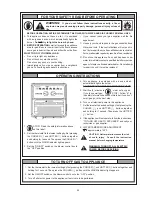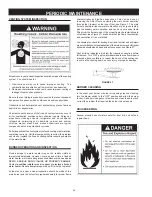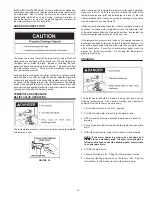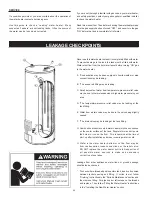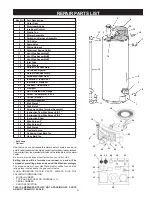
22
8. Take the end of the tube at the bottom of the floor and route it to
a suitable drain. This will provide an area where the condensate
can drain without affecting the area around the appliance.
9. Once installed along with the rest of the vent configuration,
make sure to operate the unit through at least one heat up
cycle to ensure there is no leakage around the hose barb or
any joints of the VAA or vent pipe system.
FIGURE 23: Typical Horizontal Installation
Installation for VAA with 3 & 4 inch Pipe for Vertical Vent
Some applications may require the use of 3 or 4 inch vent pipe for
longer vent lengths. Please refer to the Figure 24 as you review
these instructions. Refer back to the vertical VAA installation steps
but with the following changes to the vent construction.
3 inch vent (Vertical VAA Installations)
The VAA is designed to accommodate only 2 inch vent pipe. The
installer must use 2 inch vent pipe between the blower assembly
and the inlet into the VAA. On the outlet side of the VAA, a short run
of 2 inch vent pipe is required. Each of the short pieces of 2 inch
pipe entering and exiting the VAA must not exceed 6 inches (15 cm)
in length. From this point on, a 2 inch to 3 inch adapter may be
used. From the 2 inch to 3 inch adapter, the installer may use up to
65 equivalent feet (19.8 m) of pipe, see Figure 24 for typical
installation.
4 inch vent (Vertical VAA Installations)
The VAA is designed to accommodate only 2 inch vent pipe. The
installer must use 2 inch vent pipe between the blower assembly
and the inlet into the VAA. On the outlet side of the VAA, a short run
of 2 inch vent pipe is required. Each of the short pieces of 2 inch
pipe entering and exiting the VAA must not exceed 6 inches (15 cm)
in length. From this point on, a 2 inch to 4 inch adapter may be
used. From the 2 inch to 4 inch adapter, the installer may use up to
128 equivalent feet (39.0 m) of pipe, see Figure 24 for typical
installation.
Remember to operate the unit for at least one heat cycle to
ensure there are no air leaks in the vent joints of the VAA and
the vent pipe system. Air leaks will allow flue gas by-products
to disseminate into the room creating an unsafe environment
and could cause illness, asphyxiation and/or even death.
FIGURE 24: Typical Installation for Vertical Vent with 3 or 4 inch Pipe
Installation of VAA with 3 & 4 inch Pipe for Horizontal Vent
Some applications may require the use of 3 or 4 inch vent pipe for longer
vent lengths. Please refer to the Figure 25 as you review these instructions.
Refer back to the horizontal VAA installation steps but with the following
changes to the vent construction.
3 inch vent (Horizontal VAA Installations)
The VAA is designed to accommodate only 2 inch vent pipe. The
installer must use 2 inch vent pipe between the blower assembly and
the inlet into the VAA. On the outlet side of the VAA, a short run of 2
inch vent pipe is required. From this point on, a 2 inch to 3 inch adapter
may be used. From the 2 inch to 3 inch adapter, the installer may use
up to 52 equivalent feet (15.8 m) of pipe. This is 8 equivalent feet (2.4
m) less than the original 60 equivalent feet (18.3 m) specified with
one elbow due to the 2 inch elbow instead of a 3 inch elbow required
for the vent from the blower to the inlet of the VAA, see Figure 25 for
typical installation.
4 inch vent (Horizontal VAA Installations)
The VAA is designed to accommodate only 2 inch vent pipe. The installer
must use 2 inch vent pipe between the blower assembly and the inlet into
the VAA. On the outlet side of the VAA a short run of 2 inch vent pipe is
required. From this point on, a 2 inch to 4 inch adapter may be used. From
the 2 inch to 4 inch adapter, the installer may use up to 102 equivalent feet
(31.1 m) of pipe. This is 18 equivalent feet (5.5 m) less than the original
120 equivalent feet (36.6 m) specified with one elbow due to the 2 inch
elbow instead of a 4 inch elbow required for the vent from the blower to
the inlet of the VAA, see Figure 25 for typical installation.
Remember to operate the unit for at least one heat cycle to ensure
there are no air leaks in the vent joints of the VAA and the vent pipe
system. Air leaks will allow flue gas by-products to disseminate into
the room creating an unsafe environment and could cause illness,
asphyxiation and/or even death.
FIGURE 25: Typical Installation for Horizontal Vent with 3 or 4 inch


















